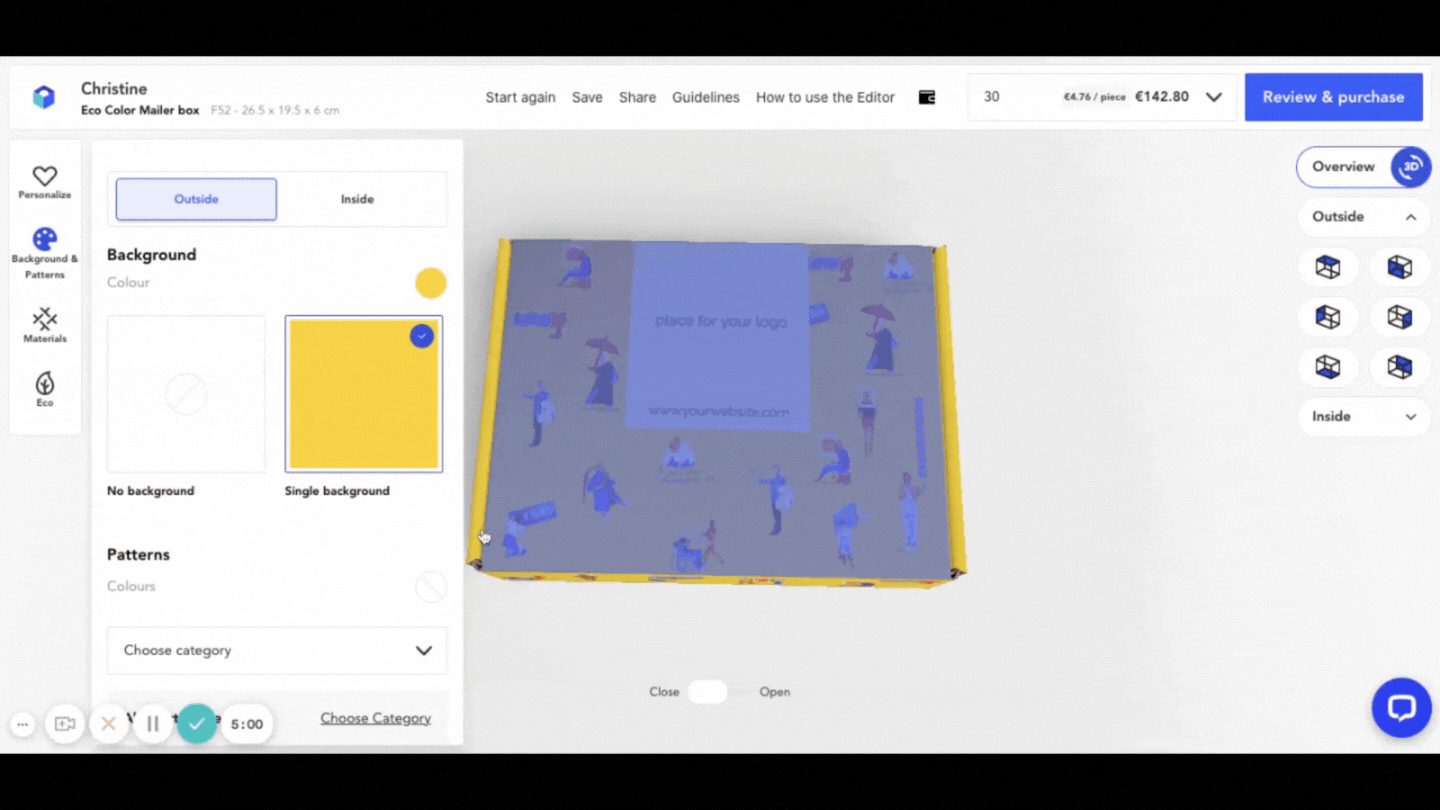What Is Inventory Turnover Ratio and Why You Need to Know Yours


Subscribe now! Receive 15% discount.
Don’t miss out – get 15% off your first order when you join the newsletter. It’s fast, free, and kinda smart.
You're now subscribed!
In this article:
- What is an inventory turnover ratio?
- What you need to calculate your inventory turnover ratio
- How to calculate your inventory turnover ratio
- What should you be looking for in your inventory turnover ratio?
- What info can you gain from your inventory turnover ratio?
- Increasing inventory turnover
- Get Measuring
Extending and diversifying your product range can help your business thrive.
But, the bigger the assortment, the more complicated your inventory management. And the less control you have over it, the less efficient you are at selling what you have.
Part of a good business strategy is knowing the performance of your products.
How quickly are you selling the stock that you hold? How often do you need to restock? To find the answers to these questions, you need to know your inventory turnover ratio.
In this article, you will learn:
- What constitutes an inventory turnover ratio
- How to calculate your inventory turnover ratio
- How to analyse the results of your calculations
- How improving your ratio can help you reduce operational costs.

What is an inventory turnover ratio?
Inventory turnover ratio tells you how many products in your inventory have been sold, shipped, and replaced over a specific period. With proper inventory turnover ratio analysis, you can accurately predict when you will need to restock each product.
Slow-moving inventory? Read about its negative effects on your business and how to prevent them
Whether you’re selling on Amazon or in a high street store, the inventory turnover ratio should be your go-to metric.
With customers encountering your brand from many different e-commerce touchpoints, it’s vital that you stay on top of your inventory levels and don’t run out often. If your products are regularly out of stock, your customers might lose interest in buying from you.
Did you know that due to stockouts, 7.4% of CPG revenue in the US was lost in 2021? That's $82 billion of unrealised revenue. (NielsenIQ)
Not to mention all the stock you had to throw away due to expiration or lack of warehousing space. Such inventory management mistakes will cost you if you don't know your ratio.
To calculate the turnover, unfortunately, you'll have to do some math.
But don't despair!
"Math" might sound daunting, but it involves a very simple equation.
What you need to calculate your inventory turnover ratio
You first need to know the cost of goods sold and the value of your average inventory.
Cost of goods sold (COGS)
The cost of goods sold (COGS) is the price of purchasing or manufacturing a product that has been sold to a customer.
Think about the different factors involved in acquiring your products. If you're a D2C brand manufacturing your own products, you’ll have costs in multiple areas, including materials and labour.
Let’s imagine, for example, that you're a chair company. To produce a chair, you will probably need wood, screws, fabrics, and somebody to assemble it.
Obviously, if you buy and resell products, it’s a much easier calculation. Essentially, you’ll need to calculate the cost of purchasing an item.
But in each case, when you're selling physical products, don't forget to add the cost of your product packaging. Fortunately, there are ways to reduce that.

Packaging doesn't need to drain your budget. See how Raylo decreased their packaging costs by 11%
Average inventory
Working out your average inventory begins by looking at similar figures to the cost of goods sold.
You’ll need to begin by calculating the value of your inventory. Instead of looking at items that you’ve sold, you’re measuring the cost of items that you still have in your inventory.
Again, you have to look at the price of manufacturing and labour or the cost of buying a product.
Once you know the value of your inventory, you can calculate the average inventory during a specified time period.
To do this, you’ll need to add the value of your inventory at the beginning of a fiscal period to the value at the end of the fiscal period. Then divide your answer by two.
Make sure that you identify a relevant time period when working out your average inventory.
What information are you looking for?
Do you want to work out your inventory over a short period of time, such as a month?
Or would you rather find the average over a longer period, for instance, a year?
Measuring over a longer period will likely yield more reliable information. Some products do better at certain times of the year, so measuring over a short period may provide skewed data.
On the other hand, if you’re in a fast-changing environment, you may wish to choose a shorter period to keep on top of trends.

When you choose a time period, make sure that it’s the same across both your cost of goods sold and your average inventory. Otherwise, you‘ll be comparing different metrics and receiving unhelpful data.
That’s no use to anyone and is a major inventory management mistake.
Free up your cash flow with an inventory control chart. Learn more
How to calculate your inventory turnover ratio
Now that you’ve worked out your COGS and your average inventory simply divide one by the other. There you have it, your turnover ratio!

Example
Let’s say you want to measure turnover over a one-month period, January.
First, take the cost of your stock on 1 January, say $20,000. Then add the cost of stock held on 31 January - $30,000. Now, divide the answer by 2 to get the average value:
$20,000 + $30,000 / 2 = $25,000
Now, calculate the cost of goods sold during January. Let’s say this was $75,000.
Now, divide the cost of goods sold by the average inventory:
$75,000 / $25,000 = 3
This tells you that you‘ve sold and replaced your inventory three times over this period.
What should you be looking for in your inventory turnover ratio?
In general, a higher rate of turnover is an indication of success. But a high ratio is not necessary for your business to make a profit.
For example, for a luxury automotive company, selling only a few cars over a specific period of time is the right tactic. High-end cars must feel exclusive.
On the other side of the spectrum is a grocery store which sells many low-cost items. In order to succeed, it will need a higher level of inventory turnover.
But even for a grocery store, high inventory turnover can be problematic. It might indicate you have sold out too quickly because you haven't sufficiently stocked your shop.
And we already know what stockouts mean for your business.

So, when carrying out your inventory turnover ratio analysis, always consider the context of your business.
Remember that the inventory turnover ratio is just one of many metrics that help you figure out the health of your business.
You’ll need to look at various indicators (such as cash flow and income profit) to get a balanced view. An auditing software can help you gain insights into the risks faced by your business.
What is Multichannel Inventory Management? Read all you need to know
What info can you gain from your inventory turnover ratio?
Here are some practical uses for your calculated ratio:
You can spot market trends more easily
Market demand for products fluctuates frequently. It's worth investing in the ability to spot these trends before they occur.
Your inventory turnover ratios can help you notice and anticipate changes more easily - and adapt to whatever's going on. By figuring out early on the direction in which your market is going, you can make better business decisions.
When you’ve spotted a trend, make sure that it’s communicated across your organisation.
Your sales team will be most eager to know about market trends and how they can capitalise on them. With a remote desktop app for Mac, you can help your teams get visibility across other areas of the business.
It enables better inventory planning
Inventory planning is always important. But there are some industries where it’s especially crucial.
This is particularly the case for the perishable goods industry. If stock isn’t sold, it will go out of date. This is known as “dead stock”. To avoid this, a business needs to be able to plan its inventory in a way that guarantees sales.

If your business does run out of stock, you need to ensure you have customer support to reassure buyers that stock will be replenished soon. Consider investing in virtual agent software to ensure you have the tools to provide the best customer service.
With inventory turnover ratio analysis, a business can gain a better sense of the number of products it sells during different periods.
This way you know the optimum number of items to order.
Still have trouble estimating? Consider having a vendor-managed inventory - it can take a lot of the pressure off.
You know how much packaging you have to order
Planning your inventory is essential, and that involves calculating the amount of packaging you need ahead of time.
Especially if you use custom packaging, your supplier will need time to manufacture your personalised boxes, bespoke bags and custom labels. And count in shipping time.
To make sure you're on top of things, use your turnover ratio to plan how much inventory you need, and, consequently, the minimum number of packaging items.
If you're ordering more packaging than you have space to keep, you will also need to factor in a packaging warehousing service. You don't want your paper envelopes all wrinkled and your custom wine tubes smashed.
These are all great reasons to plan your packaging order ahead of time, and your inventory turnover ratio is here to help.
It's easier to fix your supply chain issues
Issues with your supply chain can have many knock-on effects. Your customers might get their items late. You might be plagued with stockouts.
Spotting and addressing supply chain disruption is essential to limit the damage. Your inventory turnover ratio analysis can be a simple and effective way of spotting issues.
1. Are your products spending too long in production?
Monitoring inventory turnover can help you identify changes in lead time - the amount of time between the beginning and end of a production process.
2. Do you find that items are frequently selling out, leaving customers unable to buy their products & disappointed?
Ratio analysis can help you allocate appropriate amounts of safety stock, the amount of extra stock needed to prevent stockouts.
3. Would you like to optimise your supply chain costs?
With a calculated turnover ratio, you get to plan way ahead and plan your logistics. If managed well, your warehousing and transportation costs can go down without straining your supply chain.

Increasing inventory turnover
Now that we’ve explained the science behind and the benefits of the inventory turnover ratio, let’s look at some of the best ways to boost it.
Generate customer demand
You don't want to hold onto inventory longer than you need to. A slow-moving inventory will only damage your profit margins.
Boosting customer demand should help, but how to do it in a short period of time? Here's a handful of ideas:
Run a sale.
A discounted price is a strong incentive, regardless of how you look at it. Even better if you create a feeling of urgency and let your customers know it is a limited-time offer. But make sure the deals don't overstay their welcome when stock is low.
Advertise on social media.
Maybe consumers are simply unaware that you are selling what they need. Or, maybe they haven’t yet identified how your product can relieve their pain points. Invest in great marketing - it's worth it.
Recruit brand ambassadors.
You can either incentivise your customers to organically promote your products on social media and leave reviews, or hire influencers to be the face of your brand.
Rethink your presentation.
This can be a quick fix, like redesigning your packaging a little bit and improving your product descriptions, or a long-term reshaping, including website remodelling or rebranding. Either way, don't stay stagnant for too long, because the competition never sleeps.

Boost demand forecasting
While customers may like a certain product today, there’s no guarantee that they will still be buying it tomorrow. Accurate demand forecasting helps you predict the products that are likely to be a hit in the days and months to come.
To improve the quality of your demand forecasting, you should first consider how you are handling your current calculations. If you're only basing your analysis on a fixed number of stock days, you might be doing it wrong.
To be more accurate with your demand forecasting, take into consideration patterns of seasonal demand and market volatility.
Refine your approach by incorporating analytics data based on historical sales to get the most detailed picture possible. Your future decision-making process will be way more data-based.

Get Measuring
Good inventory management is the first step toward good business management.
If you fail to properly manage your inventory, you’ll have a much less effective and efficient organisation. This means you run the risk of ordering too many (or too few) items. This, in turn, means wasted resources or lost sales and lower revenue.
The good news is, you now know how to calculate and analyse your inventory turnover ratio!
Now you're much better equipped to make informed decisions about your stock. Get your facts and numbers right and you’ll be making more profit in no time and delivering your products on time.
With your inventory sorted, you can now move on to learning about other important elements, such as ensuring that your business uses payroll services for small businesses or that your website is personalised and offers the best user experience.
So, don’t delay. Start measuring now, and make inventory issues a thing of the past!










